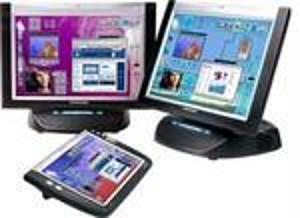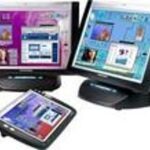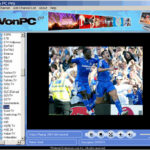By 2006 nearly half of all housing starts will include “structured wiring.” With this specialized “smart” wiring package, you can connect multiple computers within your home, view different satellite channels on multiple TVs, monitor security cameras from your TV or PC, and control your home’s energy consumption from anywhere in the world. A structured wiring package uses high-speed cabling and a distribution hub to network electronic devices inside the home. Generally, two runs of RG-6 coaxial cabling are included, along with two runs of Category 5 communications cabling.
Standard telephone wire doesn’t have the bandwidth to handle today’s communications requirements. It’s like trying to send a bullet train down a dirt road. Category 5, or “CAT 5” as it’s often called, can move information around your home 10 times faster than the usual copper telephone wire. A basic home network can also be supported by distributed Category 5 cabling, so you can share computers and printers, as well as Internet access.
RG-6 coaxial cable is a high-speed entertainment cable, primarily used to deliver satellite and cable TV signals to multiple TVs throughout the home. It has more bandwidth than the traditional RG-59 coax, and more bandwidth means a better TV picture, as well as the ability to support high-definition signals. Because the RG-6 coaxial and CAT 5 communications cabling are frequently run together to multimedia outlets, they are often bundled to simplify the installation.
However, the wire is only one part of the equation. Someone has to direct the traffic on the information highways running around your home. That’s the job of the distribution hub. (It might also be called a “wiring closet” or a “service center.”) This metal box is the destination point for all cabling: Installed in your basement or utility room, the hub intelligently routes audio, video and data signals to multiple devices around your home.
The system is similar to the one used by electrical breaker panels in controlling electricity flow. Outside services, including cable TV, telephone, DBS satellite, and the Internet, enter the hub and are distributed to locations throughout the house. Wiring for all lighting, security and other systems in the home terminates at this centralized distribution center.
The signals and information that come from the distribution hub and travel over the high-speed cabling terminate at a multimedia outlet. Installed in each key area of your house, these wall plates can be customized to your specific needs, based on which services you want in each room (cable, Internet access, telephone, etc.).
Do I Need More Fiber?
Fiber-optic cable is the hot buzzword of the moment. While expensive and difficult to install, fiber nonetheless adds serious bandwidth to any home. In fact, a single strand of optimized optical fiber could carry every phone conversation in the United States simultaneously.
Fiber-optic cable can carry voice, video and data signals simultaneously at an amazing rate of 60 gigabits per second (Gbps). Compare that with the 100-megabits-per-second (Mbps) speed of some CAT 5, and what once seemed fast enough now seems to creep at a snail’s pace. And fiber will never pick up electromagnetic interference, because it travels as light, not electrical current.
Optical fiber-optic cabling now costs only slightly more than high-quality Category 5 cabling. Many structured wiring providers, such as Futuresmart, are bundling optical fiber with Category 5 and coaxial cable.
Do you need that kind of bandwidth inside your house? Probably not now, but you could in the future. And after all, you’re going to be living in your house for a long time.
How Do I Buy?
Wiring is not expensive. The investment you make now is well worth the benefits you will reap in the long term. You’ll pay a mere 10 to 20 cents per foot for CAT 5 or RG-6 cable in your house, so run more wire than you think you’ll need.
Be aware that some companies may call their products “structured wiring packages” when, in fact, all they’ve done is “take the existing telephone and TV requirement and provide a connection and good cable for that,” warns Doug Fikse, president of OnQ Technologies, a major supplier of structured wiring packages. To enjoy a true distributed network in your home, you’re going to need a wiring system with more intelligence.
That intelligence comes in the form of “modules,” which are installed in the distribution panel. While structured wiring panels and wire differ very little from one manufacturer to another, the modules that provide this intelligence and install into the distribution panel can offer a wide variety of functions. Without these modules, a distribution panel is nothing more than a box at which wiring terminates.
One module, for example, might support a computer network and allow PCs to share high-speed Internet access; another might distribute satellite television signals to various rooms in the house. Modules can be added and upgraded easily, unlike the wire itself, allowing you to take advantage of new technologies as they become available or as your needs change or increase.
With so many options available, it’s difficult to pinpoint a cost for a structured wiring system. Generally, the range is from $750 to $2,000, installed, but the packages vary widely by manufacturer. UStec, for example, has a starter package that costs roughly $500 (labor not included) and can be upgraded with modules that support telephone, video, satellite or PC networking. In comparison, OnQ includes 350 feet of CAT 5 and RG-6 cabling in its starter package, along with a module for telecom (four incoming lines to six extensions) and a passive video module (one signal can be transmitted to four televisions). The OnQ package costs about $600 installed.
What About Wiring Upgrades?
One of the best ways to prepare for future wiring upgrades is to have an installer run conduit in your home. This empty pipe or tubing can be placed behind the walls, while they’re still open, so that new wiring can be added later, if necessary.
Obviously, it’s much easier and less expensive to integrate structured wiring into a new home while the walls are open. However, existing homes can be rewired or upgraded. Just be prepared to spend more money for the labor costs of running the wire, and expect to live with the dust for awhile.
New technologies are developing to make it easier to network devices in an existing home. Cable operators and other manufacturers are working on solutions to integrate home systems through the set-top box, while new technologies such as IEEE1394, also called “FireWire,” might eventually make home networking as simple as plugging in a lamp.
SIDEBAR: Recommended Wiring
A structured wiring system should consist of the following:
• two CAT 5 cables
• two RG-6 quad-shielded coax cables;
• one dual CAT 5/dual coax outlet in key rooms in the house, including home office/den/study, kitchen, family/great room, each bedroom, multimedia room, master bathroom, utility room, dining room.
Recommended wiring provides for basic and advanced services, including multimedia and interactive communication services. This package supports both current and developing technologies, including multiple communication technologies in the home office (multiple computers, fax machines, phone lines, etc.) and extensive home-theater capabilities (DVD, etc.).




